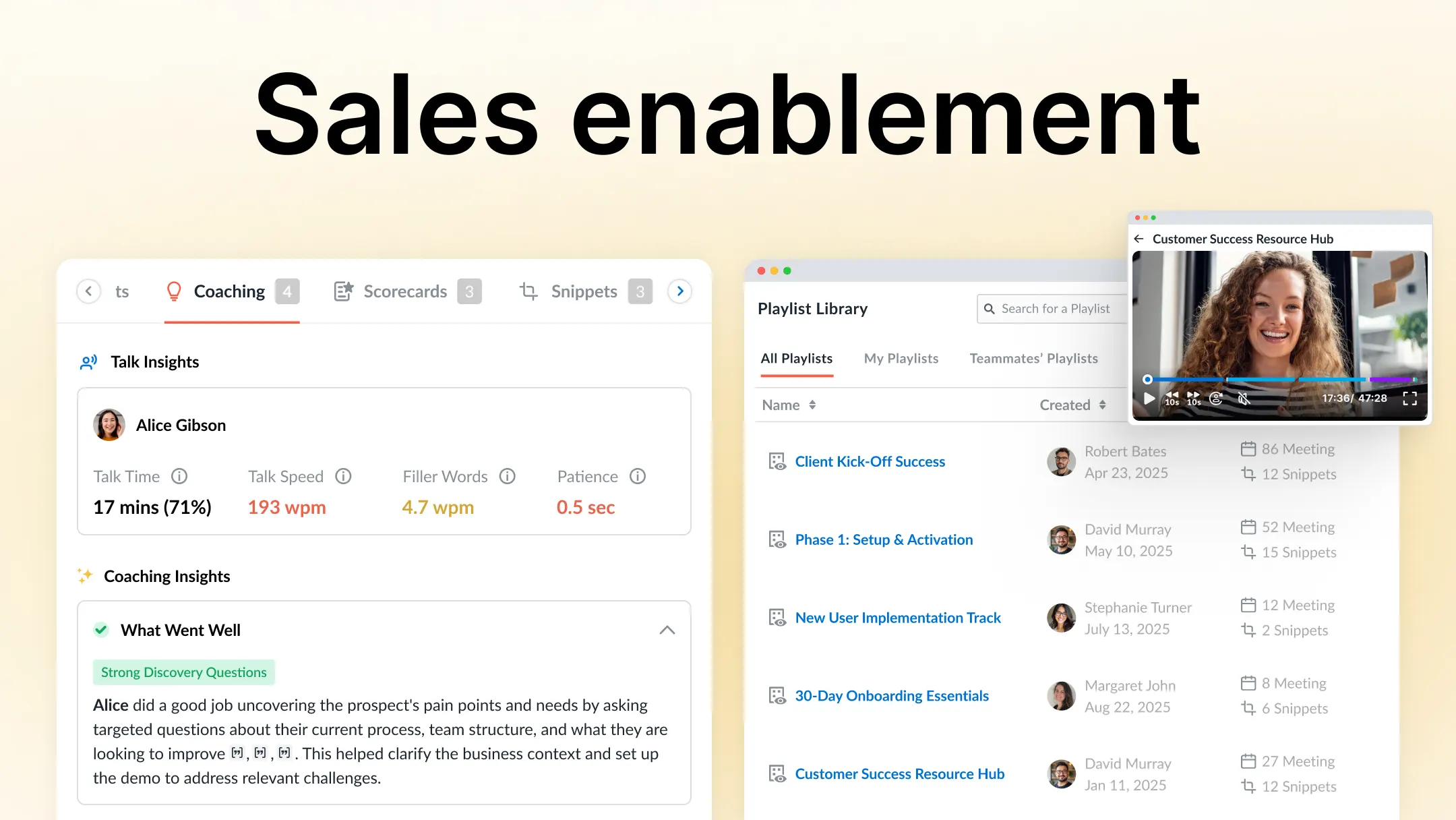The 6 best ways to improve sales rep productivity
Table of Contents:

Most B2B sales teams mistake activity for productivity. They count calls, log demos, and track CRM updates, thinking those numbers prove performance. But activity alone doesn’t drive growth.
Productivity is about outcomes, the quality of conversations, how efficiently deals progress, and how consistently reps hit their goals.
If you’ve added headcount, rolled out new tools, or tightened reporting and still feel stuck, the problem isn’t effort. It’s focus.
Here are the best ways to improve sales rep productivity and how AI-powered rep productivity software can help your team close more deals in less time.
1. Redefine productivity beyond activity
Not every call or meeting moves the needle. Counting them just gives you volume without context. True productivity measures how effectively reps convert opportunities into next steps.coaching
That’s why leading sales teams are shifting from quantity-based metrics (calls booked, demos run) to outcome-based ones (qualified opportunities created, deal velocity improved).
Tools like Avoma help you analyze conversation patterns like talk ratios, topics discussed, next steps agreed on, so you can understand which actions actually drive revenue.
When you evaluate reps on outcomes instead of output, you encourage smarter selling, not just busier calendars.
2. Automate low-value work
Sales reps spend nearly 20% of their week on manual admin tasks like taking notes, entering data, or updating CRMs. That’s one full day not selling.
You can eliminate most of that overhead with automation:
- Automate note-taking. Let AI capture and summarize every call so reps can stay focused on the customer.
- Sync CRM data automatically. With Avoma, meeting notes and action items flow directly into your CRM.
- Automate follow-ups. AI-generated reminders and templates ensure no next step falls through the cracks.
Sales teams using Avoma to automate note-taking and CRM updates see up to a 50% boost in rep productivity. It’s simple: when you remove busywork, reps have more time to sell.
Example: Directus boosts rep capacity with automation
When Directus adopted Avoma to replace their manual meeting transcription and CRM updates, the team gained back 20 hours per week and their AEs were able to handle 15 more discovery calls weekly.
Enterprise AE Pedro Pizarro cut his follow-up time by 89% using Avoma’s AI-generated email summaries and automatic HubSpot sync.
"Avoma is cost-effective and scales with us as we grow. Its post-recording features and revenue intelligence tools make it far more valuable than the other solutions we evaluated," Pedro shared.
That’s the impact of letting AI handle the repetitive work, your team focuses on selling, not software.
3. Coach smarter with conversation intelligence
Generic coaching produces generic results. Every rep has different strengths and gaps. Then why coach everyone the same way?
AI-driven conversation intelligence helps you personalize coaching without listening to every call manually. Avoma automatically scores conversations, flags moments worth reviewing, and identifies where each rep can improve.
Instead of broad advice like “ask better discovery questions,” you can give time-stamped, specific feedback: “See minute 14. Try reframing the customer’s concern here.”
This kind of targeted, time-efficient coaching helps reps grow faster while freeing up managers to focus on strategic deals.
4. Streamline the tech stack
Sales teams today use an average of 100+ SaaS tools. Too many tools lead to context switching, duplicated data, and frustration.
In fact, as per HubSpot, nearly 45% of sales professionals are overwhelmed by how many tools are in their tech stack.
More apps don’t equal more productivity.
All-in-one platforms like Avoma bring meeting recording, call summaries, CRM sync, and deal insights under one roof. That means reps spend less time toggling between apps and more time advancing deals.
A simplified workflow creates mental space for selling.
5. Improve deal visibility with AI insights
When deal data is scattered, it’s hard for sales leaders to know where things stand. Reps might miss stalled next steps, unaddressed objections, or silent decision-makers. That’s how deals slip away.
AI-powered deal insights bring clarity. Avoma’s analytics surface red flags automatically, showing you:
- Which deals are at risk and why
- How engaged key stakeholders are
- Where follow-ups or pricing discussions are stuck
This level of visibility lets managers act early and coach reps before it’s too late to recover a deal.
6. Create predictable habits
Predictability leads to productivity. The best salespeople don’t rely on habits. They block time for prospecting, debrief calls daily, and follow through on next steps without reminders.
At Avoma, we call it backcasting: start from your revenue goal and reverse-engineer daily actions that make it achievable.
We also encourage reps to use AI insights and playlists of top calls to self-coach and refine their skills continuously. When routines are clear and consistent, performance compounds naturally.
The AI advantage: why productivity gains compound
Improving productivity needs removing friction. That’s where AI helps most.
ChallengeAI-powered fixLost insights after callsAutomatically capture and summarize every meetingInconsistent coachingReal-time analysis and call scoringMissed follow-upsAutomated reminders and templatesPoor deal visibilityDeal health analyticsInaccurate forecastingAI-driven revenue predictionsManual data entryAuto-sync with CRM
By automating repetitive tasks, surfacing insights, and giving managers real visibility, AI tools help sales teams work smarter.
Real results from leading sales teams
Sales leaders across industries use Avoma to improve sales productivity and drive better outcomes.
“Our top salespeople couldn’t live without Avoma.” — Tim Powers, Zilliant
“We thought we had a decent solution until we got Avoma. That was a game changer for us.” — Rebecca Graves, Spot On
“It’s ten vs one in terms of, ‘Hey, we prefer Avoma.’” — Luiz Cent, Mailshake
And the results speak for themselves.
Directus, an open-source data platform based in New York, adopted Avoma to streamline its sales productivity. Within weeks, the team saved 20 hours per week, increased AE capacity by 15 discovery calls weekly, and cut follow-up time by 89%.
By automating note-taking, CRM updates, and follow-up emails, Avoma helped Directus turn every meeting into a measurable productivity gain. This is a proof that when AI removes friction, productivity compounds naturally.
Key takeaway
The best ways to improve sales rep productivity have little to do with doing more, and everything to do with doing the right things better.
Redefine productivity, automate manual work, coach with intent, streamline tools, and use AI to guide every conversation forward.
Because when every rep works efficiently, every deal moves faster.
Start using Avoma for free or schedule a demo to see how conversation intelligence can help your team sell smarter and scale faster.
Frequently Asked Questions
The best way to improve sales rep productivity is to automate low-value work, focus on outcome-based metrics, and coach reps using real conversation data. AI tools like Avoma help streamline workflows, reduce manual admin, and give managers visibility into what drives results.
AI captures and analyzes every customer conversation, automates notes, syncs CRM data, and flags deal risks. This saves reps hours each week, improves follow-up consistency, and helps managers coach smarter instead of harder.
Common causes include manual data entry, unclear coaching, tool overload, and lack of deal visibility. When reps spend more time on admin than on selling, performance drops fast.
Move beyond counting activities like calls or demos. Track metrics such as qualified opportunities, deal velocity, and conversion rates. Combine quantitative data with qualitative insights from call reviews for a complete picture.
Conversation intelligence platforms like Avoma are designed to improve sales productivity through automated note-taking, CRM sync, AI-powered deal insights, and scalable coaching.
Avoma automates the note-taking and CRM update process, provides AI-generated follow-ups, and offers deal intelligence dashboards. It helps sales teams stay organized, close more deals, and improve coaching efficiency—all in one place.
Teams like Directus have reported saving 20 hours a week, handling 15 more discovery calls weekly, and reducing follow-up time by 89%. Avoma’s automation and AI insights deliver measurable productivity gains across sales, marketing, and success teams.






What's stopping you from turning every conversation into actionable insights?









